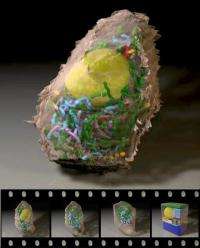Scripps Research alumnus wins International Science and Engineering Visualization Challenge

A powerful 3D animation tool created by Graham Johnson at The Scripps Research Institute has been selected as the winning video in the ninth annual International Science & Engineering Visualization Challenge.
The competition, co-sponsored by the National Science Foundation (NSF) and the journal Science, is designed to celebrate and encourage the visual communication of science for education and journalistic purposes. This year, 212 entries were received from 33 countries, representing every continent except Antarctica. For the first time this year, the public participated in the voting process, selecting their favorite images as People's Choice winners.
Johnson's entry—the result of a collaboration with Andrew Noske of the National Center for Microscopy & Imaging Research and Bradley Marsh of the Institute for Molecular Bioscience at the University of Queensland—was selected as a first-place winner in the video category by both the judges and through People's Choice.
To create the winning entry, Johnson, Noske, and Marsh worked to create a prototype of Marsh's long-term goal of visually simplifying the complex 3D data sets collected in his lab through an imaging technique known as tomography.
Their winning video, "Rapid Visual Inventory & Comparison of Complex 3D Structures," illustrates the tool that enables scientists to compare and contrast multiple parameters of complicated structures, like those found in whole-cell tomograms, at a glance. The video shows how the tool can morph beta cells into simplified geometric versions to enable the visual comparison of the organelle volumes of a single cell and how it can compare relationships between four beta cells collected by Noske, Marsh, and colleagues under different physiological conditions.
"Scientists and general audiences alike can learn a great deal about biology by comparing the internal structural differences between cells harvested from different environments, say from different parts of your body or different lifecycle stages," said Johnson, an alumnus of the Scripps Research Institute's Kellogg School of Science and Technology and a newly appointed QB3@University of California San Francisco Faculty Fellow. "Morphing the cell from the complicated native model to the simplified version and back gets general audiences excited about the subject matter and reminds even expert audiences of the complex interplay of randomness and specific interaction that enables life to exist."
Johnson, Noske, and Marsh's video and other winning entries appear in the February 3 issue of Science.
Provided by The Scripps Research Institute


















